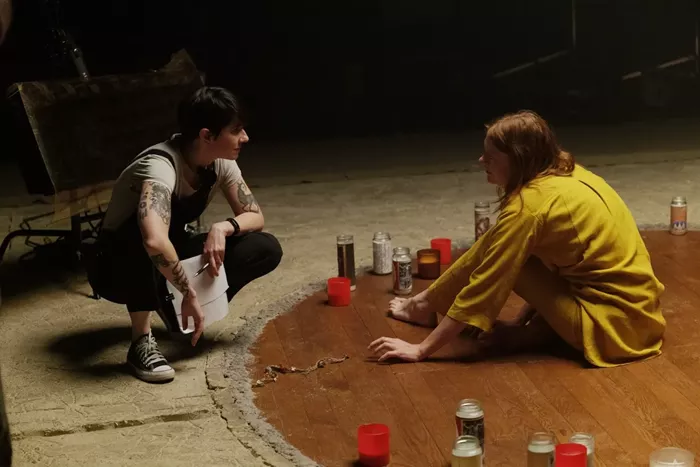In a genre known for its drawn-out development cycles, The Surrender, Julia Max’s debut feature-length horror movie, came together with remarkable speed. Filmed during the summer of 2024 and completed just a week before its South by Southwest (SXSW) premiere in March 2025, the movie debut on Shudder on May 25.
Despite the breakneck timeline, Max—who also wrote and produced the film—has delivered a chilling, emotionally grounded story. “It’s incredibly exciting but very surreal,” Max shared. “We barely made it in time for SXSW. It’s been a whirlwind, but I’m thrilled for people to finally see it.”
Max’s shift from working behind the scenes on The Swan Princess animated franchise to writing and directing a deeply unsettling horror movie might seem drastic, but for her, it was a natural evolution. “That was my day job,” she laughed. “But horror—that’s where my heart is.”
A Horror Movie Rooted in Grief
The Surrender unfolds as a psychological horror movie deeply anchored in family trauma. After the death of family patriarch Robert (played by Vaughn Armstrong), his wife Barbara (Kate Burton) refuses to let go. Pressured by her daughter Megan (Coby Minifie) to move on, Barbara instead enlists a shadowy figure known only as “The Man” to perform a resurrection ritual—with predictably horrific results.
The movie’s supernatural narrative is driven by genuine emotion, something Max says was inspired by the death of her own stepfather. “This was absolutely based on what my mother and I experienced,” she explained. “But once the actors came in, those characters became real people, not just versions of us.”
The emotional core of the story allowed Max to explore horror in a more nuanced way. “The emotional connection is what makes a scary movie land,” she said. “We needed the audience to care about these characters before unleashing the chaos.”
Casting Chemistry and Occult Accuracy
Max credits much of the film’s success to the dynamic between Burton and Minifie, who carry the bulk of the movie’s emotional weight. “We found Coby first—her audition was just lightning in a bottle,” Max said. “Then I spoke with Kate for two hours on Zoom, and I knew she was our Barbara. Once they were together in a room, the chemistry was undeniable.”
On the flip side, Neil Sandilands’ portrayal of “The Man” is eerie and nearly silent, relying more on presence than dialogue. Max and Sandilands even created a secret backstory for the character, hidden from the rest of the cast.
In a bid to keep the occult elements authentic, Max brought in an occult consultant, Kevin Wetmore. “I asked him if he had any resurrection rituals lying around,” she joked. “He said, ‘Sure! What kind do you need?’” Though Max altered the chants slightly to avoid any unwanted spiritual visitors, she was adamant about grounding the supernatural in something that felt real.
Horror as a Vehicle for Emotion
Unlike many horror films where characters act irrationally to serve the plot, Max ensures that every choice in The Surrender makes emotional sense. “It’s a tough balance,” she said. “You want the horror to hit hard, but it only works if it’s built on believable human reactions.”
The film also benefits from what Max calls “slow-burn” storytelling. She draws influence from films like A Dark Song, Relic, and even non-horror films like Blue Valentine and Black Swan, all of which shaped her vision for emotional pacing and camerawork.
“Psychological thrillers” also left their imprint on the film’s style, and the movie’s haunting opening shot—of a grotesque creature feasting on something unidentifiable—was deliberately placed to warn the audience that horror is indeed coming. “Horror fans are patient if you let them know it’ll get scary,” Max noted. “This was our promise to them.”
An Ending Open to Interpretation
Avoiding spoilers, the film’s ambiguous final scene has already sparked diverse interpretations—none more surprising than her own mother’s take, who believed Megan became a ghost. “That’s not how I saw it, but I loved that she found her own meaning,” Max said. “That’s the joy of filmmaking—once it’s out in the world, it’s not just yours anymore.”
What Comes Next
With The Surrender behind her, Max is already developing her next project. Titled Dead Rabbits, the script is another slow-burn horror tale, which she describes as her own interpretation of Rosemary’s Baby. “It’s wonderfully weird,” she teased. “It’s the one I’m most excited about making next.”
As a filmmaker, Max believes genre storytelling allows for the kind of depth that traditional drama often can’t support. “I love using genre to explore heavy emotions in a way that’s digestible,” she said. “You might not sit through a drama about grief, but wrap it in horror, and suddenly you’re willing to go there.”
With her debut feature, Julia Max has proven that horror can be both terrifying and tender. The Surrender doesn’t just scare—it resonates. And in a landscape increasingly filled with formulaic content, that’s perhaps the scariest, and most exciting, twist of all.

